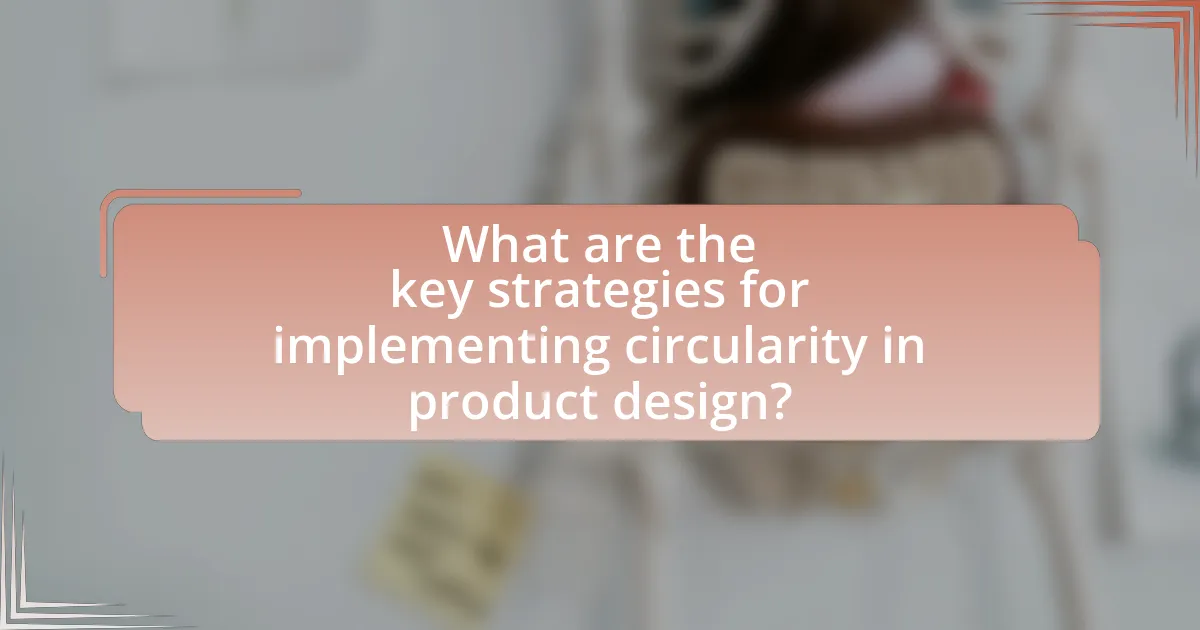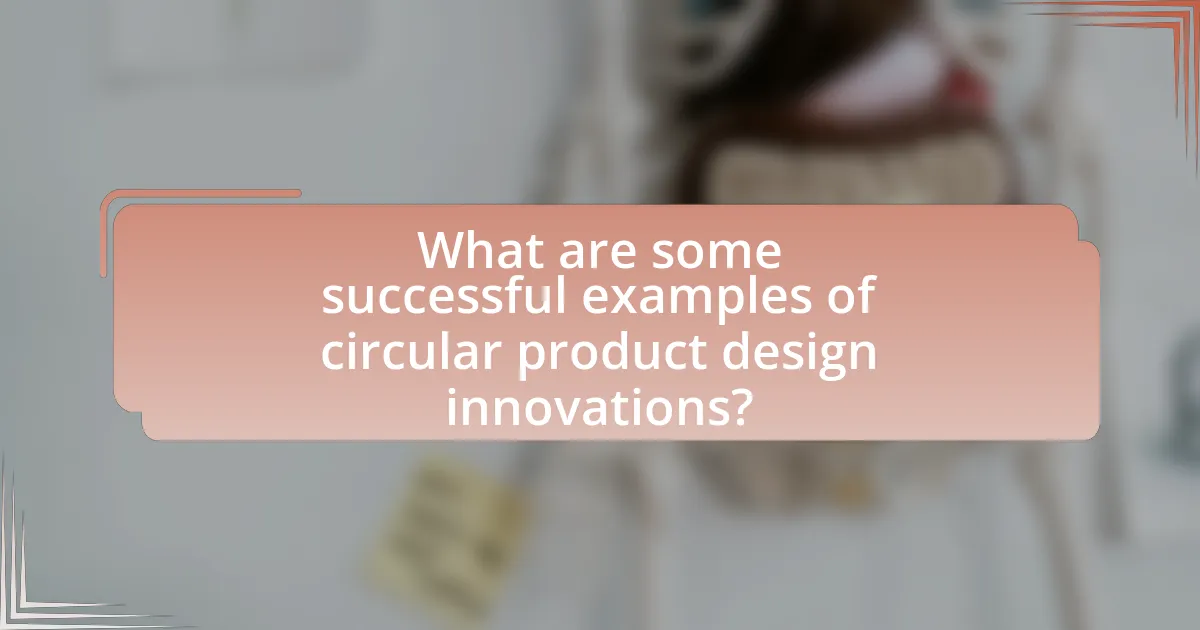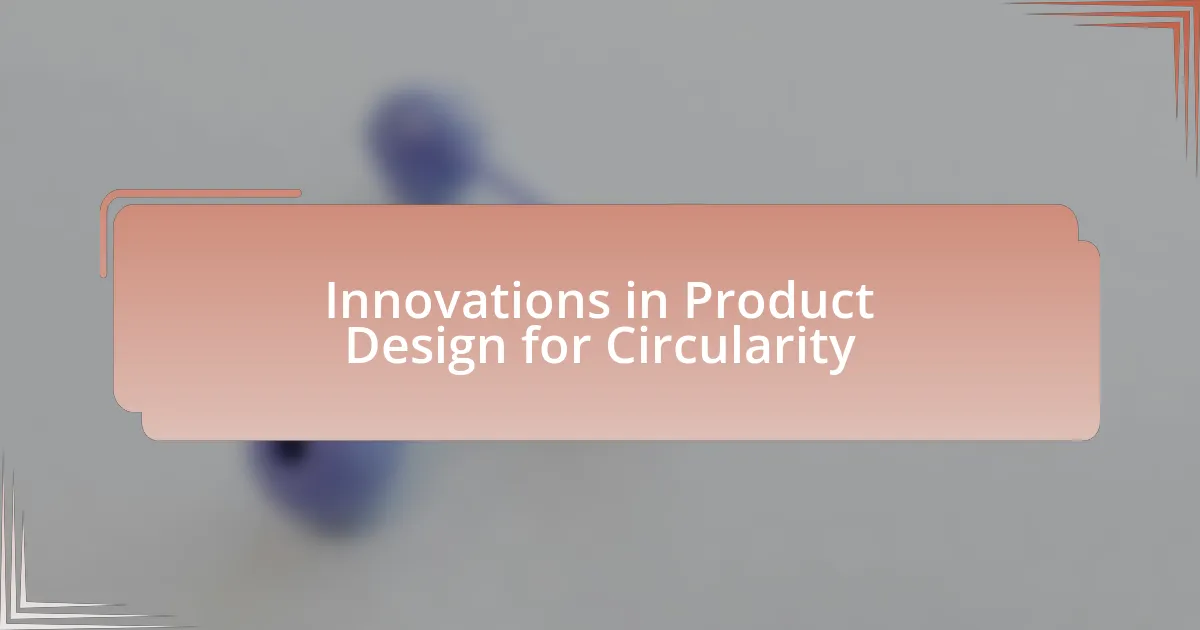Innovations in product design for circularity focus on creating sustainable products that prioritize longevity, reuse, and recyclability. Key strategies include modular design, which facilitates easy disassembly and repair, and the use of sustainable materials like biodegradable plastics and recycled metals. These innovations contribute to a circular economy by minimizing waste and maximizing resource efficiency, with principles guiding design such as durability and resource efficiency. The article also explores the environmental impacts of traditional product design, the role of technology in supporting circularity, and successful case studies from leading companies that have integrated these principles into their products.

What are Innovations in Product Design for Circularity?
Innovations in product design for circularity focus on creating products that are designed for longevity, reuse, and recyclability. These innovations include modular design, which allows for easy disassembly and repair, thereby extending the product’s life cycle. For example, companies like Fairphone have implemented modular smartphones that users can easily repair or upgrade, reducing electronic waste. Additionally, the use of sustainable materials, such as biodegradable plastics and recycled metals, is becoming more prevalent, as seen in brands like Adidas, which has developed shoes made from ocean plastic. These approaches not only minimize waste but also promote a circular economy where resources are continuously reused, thereby reducing the environmental impact of production and consumption.
How do these innovations contribute to sustainability?
Innovations in product design for circularity contribute to sustainability by minimizing waste and maximizing resource efficiency. These innovations, such as modular design and the use of biodegradable materials, enable products to be easily disassembled, repaired, or recycled, thereby extending their lifecycle. For instance, the Ellen MacArthur Foundation reports that circular design can reduce resource consumption by up to 80% in certain industries, demonstrating a significant impact on sustainability.
What principles guide circular product design?
Circular product design is guided by principles such as durability, modularity, and resource efficiency. These principles aim to create products that can be easily repaired, reused, or recycled, thereby minimizing waste and extending the lifecycle of materials. For instance, durability ensures that products withstand wear and tear, reducing the need for replacements. Modularity allows for easy disassembly, facilitating repairs and upgrades. Resource efficiency focuses on using sustainable materials and processes, which reduces environmental impact. These principles collectively support a circular economy by promoting sustainable consumption and production patterns.
How do innovations reduce waste in product design?
Innovations reduce waste in product design by implementing sustainable materials and processes that minimize resource consumption and enhance recyclability. For instance, the use of biodegradable materials and modular design allows products to be easily disassembled, facilitating recycling and reducing landfill contributions. According to a study by the Ellen MacArthur Foundation, adopting circular design principles can lead to a 70% reduction in material waste during the product lifecycle. This evidence demonstrates that innovative approaches in product design not only decrease waste but also promote a more sustainable economy.
Why is circularity important in product design?
Circularity is important in product design because it promotes sustainability by minimizing waste and maximizing resource efficiency. This approach encourages the design of products that can be reused, repaired, or recycled, thereby reducing the environmental impact associated with traditional linear models of production and consumption. According to a report by the Ellen MacArthur Foundation, transitioning to a circular economy could generate $4.5 trillion in economic benefits by 2030, highlighting the significant advantages of adopting circular principles in product design.
What environmental impacts does traditional product design have?
Traditional product design has significant environmental impacts, primarily through resource depletion, waste generation, and pollution. The extraction of raw materials for manufacturing often leads to habitat destruction and biodiversity loss. For instance, the production of plastic products contributes to over 300 million tons of plastic waste annually, much of which ends up in oceans, harming marine life. Additionally, traditional manufacturing processes frequently emit greenhouse gases and toxic pollutants, contributing to climate change and air quality degradation. According to the United Nations Environment Programme, the global waste generated from products is expected to increase by 70% by 2050 if current trends continue, highlighting the urgent need for more sustainable design practices.
How does circularity address resource depletion?
Circularity addresses resource depletion by promoting the continuous use of materials through recycling, reusing, and remanufacturing, which reduces the need for virgin resources. This approach minimizes waste and extends the lifecycle of products, thereby conserving natural resources. For instance, the Ellen MacArthur Foundation reports that transitioning to a circular economy could reduce global material consumption by 28% by 2030, significantly alleviating pressure on resource extraction.

What are the key strategies for implementing circularity in product design?
Key strategies for implementing circularity in product design include designing for longevity, modularity, and recyclability. Designing for longevity ensures products are durable and can withstand wear, reducing the need for replacements. Modularity allows for easy repair and upgrade, enabling components to be replaced without discarding the entire product. Recyclability focuses on using materials that can be efficiently processed at the end of a product’s life cycle, minimizing waste. These strategies align with the principles of the circular economy, which aims to keep resources in use for as long as possible, thereby reducing environmental impact and promoting sustainability.
How can companies adopt circular design principles?
Companies can adopt circular design principles by integrating sustainability into their product development processes. This involves designing products for longevity, repairability, and recyclability, which reduces waste and resource consumption. For instance, companies like Philips have implemented circular design by creating modular products that can be easily repaired and upgraded, thereby extending their lifecycle. Research indicates that adopting circular design can lead to a 30% reduction in material costs and a significant decrease in environmental impact, as evidenced by the Ellen MacArthur Foundation’s studies on circular economy practices.
What role does material selection play in circular design?
Material selection is crucial in circular design as it directly influences the sustainability and lifecycle of products. By choosing materials that are renewable, recyclable, or biodegradable, designers can minimize waste and resource depletion. For instance, using recycled plastics can reduce the demand for virgin materials, thereby lowering environmental impact. Additionally, materials that are easy to disassemble facilitate recycling processes, enhancing the circularity of the product. Research indicates that effective material selection can lead to a reduction in carbon emissions by up to 30% in product manufacturing, demonstrating its significant role in promoting sustainability within circular design frameworks.
How can design for disassembly enhance circularity?
Design for disassembly enhances circularity by facilitating the easy separation of materials at the end of a product’s life cycle, which promotes recycling and reuse. This approach allows manufacturers to design products that can be efficiently taken apart, ensuring that valuable materials are not wasted and can be reintroduced into the production cycle. For instance, products designed with standardized fasteners and modular components can be disassembled without damaging the materials, thereby increasing the potential for recovery and reducing landfill waste. Research indicates that implementing design for disassembly can significantly improve material recovery rates, contributing to a more sustainable circular economy.
What technologies support innovations in circular product design?
Technologies that support innovations in circular product design include digital tools such as computer-aided design (CAD), 3D printing, and advanced materials like biodegradable plastics. CAD enables designers to create and modify product designs efficiently, facilitating the integration of circular principles from the outset. 3D printing allows for on-demand production, reducing waste and enabling the use of recycled materials. Advanced materials, such as biodegradable plastics, contribute to reducing environmental impact by ensuring products can decompose after use. These technologies collectively enhance the ability to design products that are not only functional but also sustainable, aligning with circular economy goals.
How do digital tools facilitate circular design processes?
Digital tools facilitate circular design processes by enabling efficient resource management, enhancing collaboration, and supporting data-driven decision-making. These tools, such as computer-aided design (CAD) software and lifecycle assessment (LCA) tools, allow designers to visualize and optimize product life cycles, ensuring materials are reused and waste is minimized. For instance, CAD software can simulate product performance and material usage, leading to designs that prioritize sustainability. Additionally, platforms for collaborative design enable stakeholders to share insights and iterate on designs in real-time, fostering innovation. Research indicates that companies utilizing digital tools in circular design report a 20-30% reduction in material costs and improved product longevity, demonstrating the tangible benefits of integrating technology into sustainable design practices.
What role does 3D printing play in circular product design?
3D printing plays a crucial role in circular product design by enabling the production of items that can be easily disassembled, repaired, or recycled. This technology allows for the creation of complex geometries and customized products with minimal waste, as it uses only the material necessary for the item being produced. According to a study published in the journal “Sustainability,” 3D printing can reduce material waste by up to 90% compared to traditional manufacturing methods. Additionally, it facilitates the use of recycled materials in the printing process, further supporting the principles of circular economy by extending the lifecycle of materials and reducing the demand for virgin resources.

What are some successful examples of circular product design innovations?
Successful examples of circular product design innovations include the IKEA circular sofa, which is designed for easy disassembly and recycling, and the Adidas Parley shoes made from ocean plastic. The IKEA sofa allows consumers to replace individual components, extending the product’s life and reducing waste. Adidas Parley shoes utilize recycled materials, specifically plastic waste collected from oceans, demonstrating a commitment to sustainability while maintaining performance. These innovations highlight the effectiveness of circular design principles in reducing environmental impact and promoting resource efficiency.
How have leading companies integrated circularity into their products?
Leading companies have integrated circularity into their products by designing for longevity, using sustainable materials, and implementing take-back programs. For instance, companies like Patagonia utilize recycled materials in their clothing and promote repairability to extend product life. IKEA has committed to using only renewable or recycled materials by 2030, demonstrating a clear shift towards sustainable sourcing. Additionally, Nike’s “Reuse-A-Shoe” program collects worn-out shoes to recycle them into new products, effectively closing the loop in their production cycle. These strategies not only reduce waste but also foster a more sustainable consumption model.
What lessons can be learned from successful case studies?
Successful case studies in innovations for product design for circularity demonstrate the importance of integrating sustainability into the design process. These case studies reveal that early consideration of material selection, lifecycle assessment, and user engagement leads to more effective circular solutions. For instance, companies like Philips have successfully implemented circular design principles, resulting in reduced waste and increased resource efficiency, as evidenced by their “Circular Lighting” initiative, which promotes product-as-a-service models. This approach not only enhances customer loyalty but also minimizes environmental impact, showcasing that aligning business models with circularity can drive both profitability and sustainability.
How do these examples influence industry standards?
Innovations in product design for circularity influence industry standards by setting benchmarks for sustainability and resource efficiency. For instance, companies adopting modular design principles enable easier repair and recycling, prompting competitors to follow suit to meet consumer demand for eco-friendly products. This shift is evidenced by the rise of brands like IKEA, which has committed to using only renewable and recycled materials by 2030, thereby encouraging industry-wide adoption of similar practices. Such examples create a ripple effect, compelling other organizations to align their strategies with these emerging standards to remain competitive and responsible in the marketplace.
What challenges do companies face in adopting circular product design?
Companies face several challenges in adopting circular product design, primarily including high initial costs, lack of consumer awareness, and insufficient infrastructure. High initial costs arise from the need for investment in new materials, technologies, and processes that support circularity. For instance, transitioning to sustainable materials often requires significant financial outlay, which can deter companies from making the shift. Lack of consumer awareness poses another challenge, as customers may not prioritize or understand the benefits of circular products, leading to lower demand. Additionally, insufficient infrastructure for recycling and waste management can hinder the effective implementation of circular design principles, as companies rely on systems that may not be fully developed or accessible. These challenges collectively impede the widespread adoption of circular product design in various industries.
How can companies overcome barriers to circularity?
Companies can overcome barriers to circularity by implementing innovative product design strategies that prioritize sustainability and resource efficiency. By adopting design principles such as modularity, recyclability, and durability, companies can create products that are easier to repair, reuse, and recycle. For instance, a study by the Ellen MacArthur Foundation highlights that companies integrating circular design can reduce material costs by up to 30% while enhancing product lifespan. Additionally, collaboration with stakeholders across the supply chain can facilitate the development of circular business models, enabling companies to share resources and knowledge effectively.
What are the common misconceptions about circular design?
Common misconceptions about circular design include the belief that it is solely about recycling, that it requires significant upfront investment, and that it is only applicable to specific industries. Circular design encompasses a broader approach, focusing on the entire lifecycle of a product, including design for longevity, repairability, and resource efficiency. Contrary to the notion of high initial costs, many circular design strategies can lead to cost savings over time through reduced material use and waste management. Additionally, circular design principles can be integrated into various sectors, from fashion to technology, demonstrating its versatility and relevance across industries.
What best practices can guide effective circular product design?
Effective circular product design can be guided by best practices such as designing for longevity, modularity, and recyclability. Designing for longevity ensures products are durable and can withstand wear and tear, which reduces waste over time. Modularity allows for easy repair and upgrade, enabling consumers to replace only parts of a product rather than the entire item, thus extending its life cycle. Recyclability involves using materials that can be easily processed and repurposed at the end of a product’s life, minimizing landfill contributions. According to the Ellen MacArthur Foundation, implementing these practices can significantly reduce resource consumption and environmental impact, promoting a more sustainable economy.
How can collaboration enhance circular design efforts?
Collaboration can enhance circular design efforts by fostering diverse perspectives and expertise, which leads to innovative solutions. When multiple stakeholders, including designers, manufacturers, and consumers, work together, they can share knowledge about materials, processes, and end-of-life strategies, resulting in more effective circular systems. For instance, a study by the Ellen MacArthur Foundation highlights that collaborative initiatives can reduce resource consumption by up to 30% through shared logistics and material reuse. This collective approach not only drives efficiency but also accelerates the adoption of sustainable practices across industries.
What metrics should be used to measure circularity success?
To measure circularity success, key metrics include material recovery rate, product lifespan, and recycling rate. The material recovery rate quantifies the percentage of materials that are reclaimed and reused, indicating efficiency in resource utilization. Product lifespan assesses the durability and longevity of products, reflecting their design for longevity and repairability. The recycling rate measures the proportion of products that are recycled at the end of their life cycle, demonstrating the effectiveness of circular systems in diverting waste from landfills. These metrics provide a comprehensive view of circularity performance, enabling organizations to track progress and identify areas for improvement.


